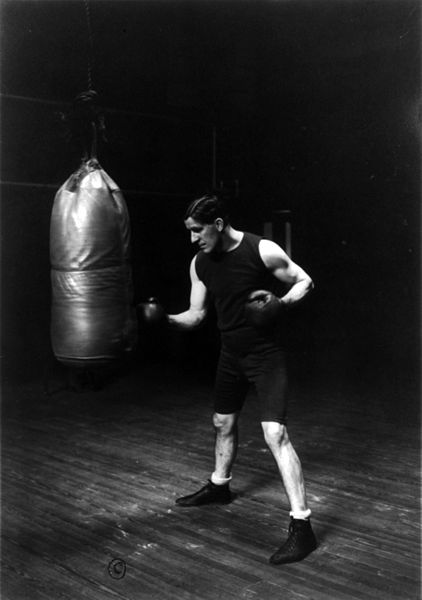 |
| James J. Corbett with a punching bag |
Matthew Allen, author of the Straight Forward in a Crooked World blog, has an article at Shooting Illustrated on the topic of what to do for training when you are "short on ammo," but "long on time." In addition to the standard dry fire and practicing draws and presentations, he also recommends:
For developing or improving upon hand-eye coordination, a punching bag is a very valuable asset to own. The misplacement of thought almost everyone has when encountering a “heavy bag” is that they should walk up and slug it as hard as they can four or five times, but the bag is ours to use as we see fit. Since my gym doesn’t have the small, lightweight speed bags normally associated with hand speed work, I use the 6.5-foot, 80-pound bag to achieve the same goal with a bonus.
Instead of focusing on hard powerfully swung punches with my hands wrapped, I strike the bag with a traditional-style punch as fast as I can, making basic light contact and with equal speed get that hand off the bag while simultaneously switching to my other hand. My personal routine is to do this as fast as I can for 30 seconds, then break for a minute or so for a “rest.” I’ll repeat this three or four more times, or rather “sets,” and I do this three times per week. In the process, I’m also working on my balance and where my feet are best situated.Also:
After the heavy bag, a second non-shooting way to work on hand eye coordination is to hit the batting cage. It’s a cheap, effective and commonly placed way of working out everything you do at the range with a few added caveats.
For those of us who are continually sparing at the gym or dojo, getting hit, shoved and thrown around helps to prepare physically and mentally for being struck and having to strike. If you cannot take part in such activities, the batting cage may give you a place where you can work on a small variety of skills both mentally and physically without anyone else realizing what you are doing.Part II of his article is here, where he discusses some other techniques. Read both parts.
No comments:
Post a Comment